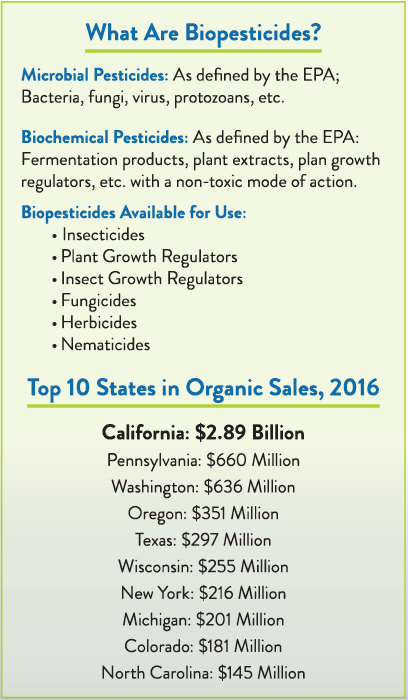By Mike Allan, Vice President, North America, Certis Biologicals
Organics and biopesticides…A Rising Tide
Consumers are more educated than they’ve ever been when it comes to caring about how their food is grown and the inputs that are being applied on them. As a result, the demand for end-use organic products continues to rise at a staggering rate.
Consider these findings from the 2019 Organic Industry Survey released by the Organic Trade Association:
- Organic food sales reached $47.9 billion in 2018, an increase of 5.9 percent.
- Much of this growth can be found in the sales of organic fruits and vegetables, which rose to $17.4 billion in 2018, a growth of 5.6 percent over the previous year. To compare, the overall fruits and vegetables category, including both organic and conventional produce, grew by only 1.7 percent.
- Organic fruits and vegetables make up 14.6 percent of all produce sold in the U.S., a near doubling of their market share in the past decade.
While these growth numbers seem to support the trend that consumers are seeking greater transparency in their food supply chain, it contributes only part of the story as it relates to the increase in demand for biopesticides. Regulatory challenges, resistance management and the increase in adoption for IPM programs also factor into the increase in demand. This has led to more and more biopesticides being applied not only on organic acreage, but increasingly more on conventional acres. In fact, in many cases, biopesticides have shown performance comparable to that of conventional chemistries for key pests and disease. This is largely due to the experience that we’ve gained through applied research, and on farm demonstrations. It is through those experiences that we’ve refined application methods, use recommendations, as well as, gaining an overall better understanding of how to best use biopesticides when used exclusively or within an IPM program.
Biopesticides…Meeting the Tide
According to Markets & Markets forecast, the overall biopesticides market is projected to grow from $3 billion in 2018 to $6.4 billion by 2023, a projection that has the market more than doubling in only five years. To meet this projected demand, you have (and will continue to) see an increasing number of registrants and manufacturers incorporating biopesticides into their product offerings. As these products become increasingly available, PCAs and growers can expect biopesticides to offer more of the following benefits:
- Broader spectrum of pest and disease control alternatives
- Safety for non-target organisms
- Complex modes of action, which reduce the threat of resistance when used in IPM programs
- Effective control of pests, to help in increasing crop yields
- Improved export and marketing opportunities for resident-exempt biopesticides
- Low REIs and PHIs, which result in worker safety and flexibility
- Approved for most uses in sensitive areas where the use of conventional chemistries are restricted and/or prohibited.
While the benefits above are widespread, there are countless specific examples of cases where biopesticides have uniquely offered solutions for some of the most challenging issues:
- Bassiana Beauveria has proven to offer control to Spotted Lantern Fly (SLF)
- Apple growers routinely incorporate virus products into their program for control of codling moth and the increasing concern for ornamental fruit moth.
- Apple growers often incorporate Bacillus amyloliquefaciens / subtilis, into their Fire Blight control programs
- Biological plant activators, Induced Resistance/Systemic Acquired Resistance products are routinely used to control several diseases in grapes.
Biopesiticides must meet strict criteria for EPA registration before they can be used in food and non-food production operations. Following EPA approval the Organic Materials Review Institute (OMRI), a non-governmental agency and the USDA National Organic Program (NOP) determine the ability for these biopesticides to be used in organic production.
Biopesticides…The Future of Protection
PCAs continue to gain experience with biopesticides and are playing an integral role in educating growers as we navigate the new frontier of balancing large-scale organic and conventional production. Luckily, PCAs and growers have an established set of tools with proven biopesticides to address many of the challenges that come along with this balance; however, there are existing and unforeseen issues that could stem from regulatory or resistance management challenges - or something else altogether. To that, we cannot rest on our laurels and must look to new technologies and advancements on the horizon.
Notable advances come in the development of bacteriophages for use in commercial agriculture. Technology that utilizes bacteria-eating phages has begun to revolutionize treatments in the medical field and now is also being successfully deployed to help combat issues from Fire Blight and Citrus Canker to bacterial spot/speck in tomatoes. Biopesticide companies are also harnessing the plants’ own power by utilizing plant activators, naturally-occurring bacterium shown to trigger a plant’s natural immune response to pathogenic fungi, bacteria and viruses.
Growers have long been considered the chief stewards of Mother Nature, unlocking her potential every day and protecting her resources for the future. With the rise in biopesticides and their adoption in organic and conventional farming, growers are now more than ever utilizing a fully integrated approach to controlling pests and diseases. These biologically based tools are an asset and a significant part of the balance between protecting crops the environment and the future of agriculture today.
What are biopesticides?
Microbial Pesticides: As defined by the EPA; Bacteria, fungi, virus, protozoans, etc.
Biochemical Pesticides: As defined by the EPA: Fermentation products, plant extracts, plan growth regulators, etc. with a non-toxic mode of action.

This article appeared in the December 2019 issue of CAPCA Adviser Magazine. You can read the original here.




